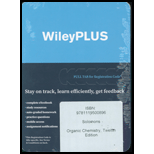
ORGANIC CHEMISTRY-WILEYPLUS ACCESS PKG.
12th Edition
ISBN: 9781119766919
Author: Solomons
Publisher: WILEY
expand_more
expand_more
format_list_bulleted
Question
Chapter 15, Problem 38P
Interpretation Introduction
Interpretation:
The mechanism which accounts for the formation of products in the given reaction is to be provided.
Concept introduction:
Conjugated dienes undergo 1,2-addition and 1,4 –addition through the formation of allylic carbocations.
Expert Solution & Answer
Want to see the full answer?
Check out a sample textbook solution
Students have asked these similar questions
Predict the product or products for the following reactions. Please include both ortho and para substitutions, if it applies, and indicate the major product, if it applies.
The bromination of naphthalene via electrophilic aromatic substitution. Please draw out all of the resonance structures created from addition at the C1 carbon. Please also draw out all of the resonance structures created from addition at the C2 carbon. Which carbon (C1 or C2) is more favored?
Predict the product or products for the following reactions. Please include both ortho and para substitutions, if it applies, and indicate the major product, if it applies.
Chapter 15 Solutions
ORGANIC CHEMISTRY-WILEYPLUS ACCESS PKG.
Ch. 15 - PRACTICE PROBLEM 15.1
Show how loss of a proton...Ch. 15 - Prob. 2PPCh. 15 - PRACTICE PROBLEM 15.3
Outline all steps in a...Ch. 15 - PRACTICE PROBLEM 15.4 Provide a mechanism that...Ch. 15 - Prob. 5PPCh. 15 - Prob. 6PPCh. 15 - Prob. 7PPCh. 15 - PRACTICE PROBLEM 15.8 Write resonance structures...Ch. 15 - PRACTICE PROBLEM 15.9
Provide a mechanism for the...Ch. 15 - PRACTICE PROBLEM 15.10 The trifluoromethyl group...
Ch. 15 - PRACTICE PROBLEM 15.11
Predict the major products...Ch. 15 - PRACTICE PROBLEM 15.12 Predict the major product...Ch. 15 - PRACTICE PROBLEM 15.13
Write mechanisms for the...Ch. 15 - Prob. 14PPCh. 15 - PRACTICE PROBLEM 15.15
Suppose you needed to...Ch. 15 - PRACTICE PROBLEM 15.16 1-Fluoro-2,4-dinitrobenzene...Ch. 15 - Prob. 17PPCh. 15 - PRACTICE PROBLEM 15.18
When...Ch. 15 - PRACTICE PROBLEM 15.19 Birch reduction of toluene...Ch. 15 - Prob. 20PCh. 15 - Prob. 21PCh. 15 - What monobromination product (or products) would...Ch. 15 - 15.23 Predict the major products of the following...Ch. 15 - Prob. 24PCh. 15 - 15.25 Starting with styrene, outline a synthesis...Ch. 15 - Prob. 26PCh. 15 - 15.27 Starting with aniline, outline a synthesis...Ch. 15 - Prob. 28PCh. 15 - Propose structures for compounds GI:Ch. 15 - 2,6-Dichlorophenol has been isolated from the...Ch. 15 - Prob. 31PCh. 15 - 15.32 Give structures (including stereochemistry...Ch. 15 - Provide a detailed mechanism for each of the...Ch. 15 - 15.34 Provide a detailed mechanism for the...Ch. 15 - Prob. 35PCh. 15 - Many polycyclic aromatic compounds have been...Ch. 15 - Prob. 37PCh. 15 - Prob. 38PCh. 15 - Prob. 39PCh. 15 - Prob. 40PCh. 15 - Predict the product of the following reaction.Ch. 15 - 15.42 When m-chlorotoluene is treated with sodium...Ch. 15 - Prob. 43PCh. 15 - Prob. 44PCh. 15 - Prob. 45PCh. 15 - Prob. 46PCh. 15 - 15.47 Provide structures for compounds A and B:
Ch. 15 - Prob. 48PCh. 15 - 15.49 Treating cyclohexene with acetyl chloride...Ch. 15 - 15.50 The tert-butyl group can be used as a...Ch. 15 - 15.51 When toluene is sulfonated (concentrated )...Ch. 15 - Prob. 52PCh. 15 - 2-Methylnaphthalene can be synthesized from...Ch. 15 - Prob. 54PCh. 15 - Prob. 55PCh. 15 - Prob. 56PCh. 15 - Prob. 57PCh. 15 - Prob. 58PCh. 15 - Furan undergoes electrophilic aromatic...Ch. 15 - A C-D bond is harder to break than a C-H bond,...Ch. 15 - 15.61 Acetanilide was subjected to the following...Ch. 15 - Prob. 62PCh. 15 - Prob. 63PCh. 15 - Prob. 64PCh. 15 - When compound C, which is often used to model a...Ch. 15 - Open the molecular model file for benzyne and...Ch. 15 - The structure of thyroxine, a thyroid hormone that...Ch. 15 - Prob. 2LGPCh. 15 - 3. Deduce the structures of compounds E–L in the...
Knowledge Booster
Similar questions
- Chapter 1 In-Class-Problem set ☺ Study The C3-C4 carbon-carbon bond in the following molecule results from the overlap of which orbitals (in the order C3-C4)? о a) sp-sp² b) sp-sp³ c) sp²-sp² d) sp²-sp³ e) sp³-sp² 7 6 M 4 3 2arrow_forwardCount how many pi and sigma bonds are in the following molecule, caffeine. Circle all sp3 hybridized atoms, box sp₂ hybridized atoms, and draw a triangle around all sp hybridized atoms. N N N Z - - N -arrow_forwardFill in the blanks of the following chart Characteristic Atomic Number Symbol amul Description Protons + Neutrons Use the following words to label the diagrams: Atomic Number, Valence State, Chemical Symbol, Number of Atoms, Molecule, Atomic Mass 40Ca 74W H₂O Na+¹ CI-1arrow_forward
- in aqueous solution, bromine oxidises sulphur dioxide so2 to sulphate ions so42- i) deduce the oxidation state of sulphur in so2 and so4 2- ii) deduce a half equation for the reduction of bromine in an aqueous solution iii) deduce a hald equation for the oxidatio of so2 in aquoes solution forming so42- and h+ ionsarrow_forwardPlease correct answer and don't used hand raiting and don't used Ai solutionarrow_forwardDraw orbitals for a and c and identify all of the molecules/functional groups' electron geometry, molecular shape and bond angles: a. H₂O b. Ketone c. Alkyne d. Etherarrow_forward
- Identify the functional groups in the following molecule, naxalone (aka narcan): HO OH Narrow_forwardBenzene-toluene equilibrium is often approximated as αBT = 2.34. Generate the y-x diagram for this relative volatility. Also, generate the equilibrium data using Raoult’s law, and compare your results to these. post excel spreadsheet w values used to generate both graphsarrow_forwardConvert the following structures to skeletal structures: a. CH3CH2CH2CH2COOH b. CH3CH2OCH2 Br C. CH2CHCHCHCCCHCH2arrow_forward
arrow_back_ios
SEE MORE QUESTIONS
arrow_forward_ios
Recommended textbooks for you
 Organic ChemistryChemistryISBN:9781305580350Author:William H. Brown, Brent L. Iverson, Eric Anslyn, Christopher S. FootePublisher:Cengage Learning
Organic ChemistryChemistryISBN:9781305580350Author:William H. Brown, Brent L. Iverson, Eric Anslyn, Christopher S. FootePublisher:Cengage Learning

Organic Chemistry
Chemistry
ISBN:9781305580350
Author:William H. Brown, Brent L. Iverson, Eric Anslyn, Christopher S. Foote
Publisher:Cengage Learning